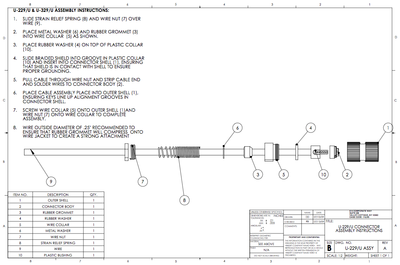Difference between revisions of "U-229"
Jump to navigation
Jump to search
RadioNerds (talk | contribs) m (1 revision) |
RadioNerds (talk | contribs) |
||
| (5 intermediate revisions by the same user not shown) | |||
| Line 1: | Line 1: | ||
| + | ;Pin A Common Ground | ||
| + | :The common ground for audio and is typically the same as chassis ground. | ||
| − | + | ;Pin B Handset speaker | |
| − | + | :Audio output to the handset speaker. | |
| + | ;Pin C Push To Talk | ||
| + | :When grounded it puts the transmitter into transmit mode | ||
| − | + | ;Pin D Mike | |
| − | + | :Microphone input to the radio. | |
| − | + | ;Pin E Not Standardized | |
| − | + | :Different radios use it for different purposes. For example: | |
| − | |||
| − | |||
| − | |||
| − | |||
| − | |||
| − | |||
| − | |||
| − | |||
| − | |||
| − | |||
| − | |||
| − | |||
| − | |||
PRC-68 Family of Squad Radios uses pin E for "12 Volt" vehicle power input. | PRC-68 Family of Squad Radios uses pin E for "12 Volt" vehicle power input. | ||
| + | :The HF manpack radios PRC-74 and PRC-104 use pin E for the CW key input, and it's also used for high speed CW like from a GRA-71. Note that the pin C PTT line can NOT be used for CW keying on a radio that supports SSB operation, since there would be no output. | ||
| + | :The VRC-12 series Squad radios uses pin E as the loudspeaker line to drive the LS-454. | ||
| + | :The PRC-25, PRC-77 AUDIO and the RT-246, RT-524 & R-442 RETRANS use pin E as the retrans PTT to key the other RT with the Mk-456 Retransmission Kit. | ||
| + | ;Pin F Not Standardized== | ||
| + | :This is the center pin that is not present on a true U-229 connector. Many radios install the 6 pin version of this connector, yet do not connect a wire to pin F. Maybe it's done to allow a future modification, or maybe just to standardize the connector? Some equipment does use this pin where the other pins are used in the above audio functions, for example: | ||
| + | :The PRC-68 Family, except the PRC-68 and PRC-68A, use this pin for digital up and down loading of the channel frequency assignments and as the retransmission PTT output. This supports a retransmission cable and cloning cable that are different than the Mk-456. | ||
| − | |||
| − | |||
| − | |||
| − | |||
| − | |||
| − | |||
| − | |||
| − | |||
| − | |||
| − | |||
| − | |||
| − | |||
| + | [[File:U-229_assembly.png|400px]] | ||
==U-229== | ==U-229== | ||
| − | |||
==U-228== | ==U-228== | ||
| − | |||
==GC-328== | ==GC-328== | ||
| − | |||
==U-183== | ==U-183== | ||
| − | |||
Latest revision as of 19:48, 23 September 2013
- Pin A Common Ground
- The common ground for audio and is typically the same as chassis ground.
- Pin B Handset speaker
- Audio output to the handset speaker.
- Pin C Push To Talk
- When grounded it puts the transmitter into transmit mode
- Pin D Mike
- Microphone input to the radio.
- Pin E Not Standardized
- Different radios use it for different purposes. For example:
PRC-68 Family of Squad Radios uses pin E for "12 Volt" vehicle power input.
- The HF manpack radios PRC-74 and PRC-104 use pin E for the CW key input, and it's also used for high speed CW like from a GRA-71. Note that the pin C PTT line can NOT be used for CW keying on a radio that supports SSB operation, since there would be no output.
- The VRC-12 series Squad radios uses pin E as the loudspeaker line to drive the LS-454.
- The PRC-25, PRC-77 AUDIO and the RT-246, RT-524 & R-442 RETRANS use pin E as the retrans PTT to key the other RT with the Mk-456 Retransmission Kit.
- Pin F Not Standardized==
- This is the center pin that is not present on a true U-229 connector. Many radios install the 6 pin version of this connector, yet do not connect a wire to pin F. Maybe it's done to allow a future modification, or maybe just to standardize the connector? Some equipment does use this pin where the other pins are used in the above audio functions, for example:
- The PRC-68 Family, except the PRC-68 and PRC-68A, use this pin for digital up and down loading of the channel frequency assignments and as the retransmission PTT output. This supports a retransmission cable and cloning cable that are different than the Mk-456.
